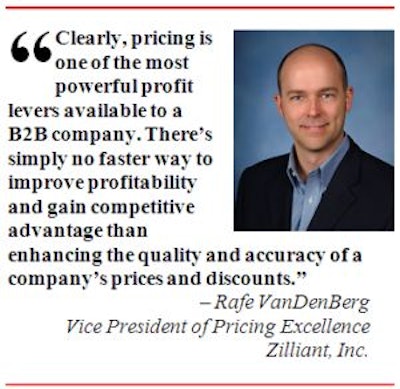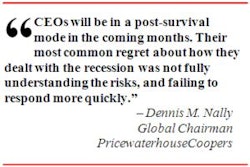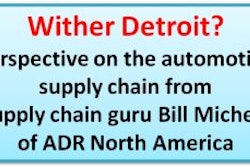
February 11, 2010 — Over the years, a perplexing contradiction has emerged in the B2B sector. On the one hand, it's fair to say that every B2B company would like to maximize their margins, improve their profit performance and, ultimately, increase their shareholder value. But on the other hand, relatively few B2B companies are focusing their attentions on the single most-powerful means to achieve all of these objectives and more: their pricing.
Why? What's preventing some B2B companies from leveraging the power of pricing to improve their performance? The fact is that what often separates those who succeed from those who struggle is a series of closely held myths about pricing in a B2B environment:
1. The Market Controls the Price
This particular myth has done more damage and cratered more markets than all the other myths combined. When executives and managers buy into this myth, they are essentially abdicating their responsibility to make sound choices for their company and shareholders, and their margins are virtually guaranteed to suffer as a result.
The reality is that the "market price" for any product, no matter how commoditized it may seem, is never just one price — it's always a range. In B2B, the range is highly dependent on a number of different factors and can, in fact, be fairly wide. Within the range, there can be dozens, or even hundreds, of valid price-points from which to choose. And the profitability impacts between the high and the low can be dramatic. So while B2B companies may not be able to control the ballpark, they can definitely decide where to play within that ballpark.
2. We Have More Important Things to Worry About
B2B executives and managers typically have a variety of "big" initiatives to consider. Do they spend $200 million on that new facility? Do they invest $100 million in R&D on that new product line? Should they try to acquire that other company or competitor? With decisions like these looming large, it's all too easy for some companies to see pricing as a relatively minor issue in the whole scheme of things.
Relative to pricing, however, there are very few things that can generate as much financial impact in as little time. While that $200 million facility may improve profits by 2-3 percent five years from now, improved pricing can increase profits 10 percent or more this year. After the dust finally settles, that new acquisition may improve earnings by 5-7 percent. Improved pricing can have a similar impact in a matter of months — with much less investment and organizational upheaval. With so much power and leverage, it's hard to imagine anything being more important to a B2B company than pricing.
3. Commodity Products Can't Be Price-differentiated
Commoditization can be self-fulfilling prophecy, as well as a crutch. Some B2B companies effectively eliminate even the slightest expectation of rational or thoughtful pricing by formally categorizing certain products as being "commodities." And the "commodity" characterization is routinely thrown around to excuse deep discounting and "anything goes" pricing behavior in the field.
In reality, there are few — if any — true commodities in this world. Take a hard look at any supposed commodity you can name and you will see lots of price variation and differentiation. There are always a variety of factors that determine what a customer is really willing to pay. Some of these factors are product-related, certainly. But many factors have to do with the customer's situation, unique relationships and services, and the circumstances surrounding the specific deal at hand. By understanding how these factors affect willingness-to-pay, B2B companies can break free of the commodity myth for good.
4. Pricing Improvement Puts Revenue at Risk
Like it or not, revenues are sacred for many B2B companies. While profit is what actually pays the bills and creates real shareholder value, these companies nonetheless measure their success by revenues. For these companies, the very idea of pricing improvement is heresy — because they believe that improved pricing will necessarily reduce revenues.
Of course, this is a misunderstanding of what pricing improvement is all about in a B2B environment. In B2B, it's not about raising overall prices and having the increased margins offset the revenue losses. Rather, the objective of pricing improvement in B2B is to precisely identify those specific situations where you can charge a little more, with minimal risk. In other words, companies still win all the business they want to win — but they do it without discounting any further than is really necessary. Instead of thinking of pricing improvement as "raising prices," revenue-oriented B2B companies should think of it as "stopping the over-discounting."
5. Experienced Salespeople Know How to Price
Established B2B companies too often assume that the more experience their salespeople have, the lower the likelihood of having any pricing problems. They assume that because their sales reps have all been in the business for 15 years or more, their pricing has got to be pretty good. Of course, seasoned sales professionals will often reinforce this belief with claims like, "Nobody knows these customers better than I do."
The reality, however, is often very different. After all, experience is simply the accumulation of learning through direct participation. Obviously, the quality of that experience depends on what was learned. And over time, consciously or unconsciously, salespeople can learn a lot of behaviors that are not conducive to profitable pricing — gaming the incentive system, guessing instead of researching, short-changing the value proposition, groove pricing across different situations, assuming competitive responses, over-estimating price-sensitivities and so on. While it may seem counterintuitive, the B2B companies with the most experienced sales teams are very often the companies leaving the most money on the table.
6. Compensating on Margin Ensures Good Pricing
By now, most B2B companies have come to understand how revenue- or volume-based compensation encourages bad pricing behavior among their salespeople. Unfortunately, too many companies have also come to believe that margin-based incentive compensation is a "silver bullet" that can knock out all of their pricing problems. These companies believe that good pricing behavior is virtually guaranteed when salespeople have a financial incentive to maximize margins.
The problem, however, is that it's in our nature as human beings to overestimate risk. As such, individual salespeople will almost always overestimate the personal risks associated with trying to get a little more margin out of the deal at hand. In their minds, the positive compensation benefit of getting that additional margin is overshadowed by the negative compensation impact of losing the deal altogether. This "something is better than nothing" dynamic causes salespeople to play it much safer than they really need to — leaving money on the table in the process.
7. Pricing Has to Be Simple to Execute
Part of this myth is true — the notion that people in the field can't execute something that's too complex. But what makes this myth such a margin-killer is the direct connection drawn between sophistication in the underlying pricing model and ease-of-execution in the field. In the interest of simple execution, companies that embrace this myth usually end-up using very basic and rudimentary pricing models — models that can't help but allow millions of margin-dollars to slip through the cracks.
Simply put, the more granular and specific the pricing model, the more profit that model is capable of extracting. And with today's pricing technology, increased complexity in the underlying pricing model doesn't automatically translate into something that's difficult or complex to execute in the marketplace. Using software, even the most sophisticated pricing models can deliver price recommendations to the field in ways that are very easy to understand and extremely simple to execute.
8. Strict Compliance to Rules Ensures Good Pricing
Many B2B companies believe that their pricing problems are simply the result of renegade rule-breaking — salespeople "going rogue" and ignoring the established pricing rules. In turn, they believe that by strictly enforcing compliance to the established rules, their company has prevented pricing problems from even occurring. In effect, these companies are saying, "Our pricing is great because our people always follow the rules."
The problem with this belief, of course, is that it assumes that the rules are accurate and effective in the first place. It assumes that the underlying pricing model has all the granularity and specificity it should have, that the breakpoints and buckets are in the right places, and that differences in price sensitivity have been accounted for. This assumption is not only flawed, it can cost B2B companies millions. The equation is really pretty simple: strict enforcement of inaccurate prices, policies and rules will always — always — result in lost sales, lost margin or both.
9. New Product Pricing Is What Really Matters
This myth usually emanates from Product Management, where they live and breathe new products. While a company's bread and butter may actually come from older products, product managers tend to enjoy the development and launch aspects of new products. Once a new product is launched and "thrown over the fence" to Sales, that's where the pricing challenge seems to end for many product managers.
The reality, however, is that the most money is left on the table through suboptimal pricing after a new product is launched. After all, most products spend the vast majority of their lifecycles under the pricing practices of the Sales group. And try as they might, without the right pricing technologies to support them, there's simply no way Sales can optimize the price of every product on every deal.
10. Sales Will Never Give up Control of Pricing
There's a common misconception that in order to achieve improved pricing performance, B2B companies must change the location of their pricing decisions. Instead of allowing salespeople to control pricing decisions, they must shift authority to a centralized pricing group. This mistaken belief has kept more than one B2B company from seriously pursuing improved pricing performance because the anticipated organizational upheaval and expected political battles associated with centralization are just too onerous.
In reality, today's pricing technology allows B2B companies to improve their pricing performance without stripping salespeople of authority and control. In this new paradigm, pricing decisions are still made in the field. In the new technology-enabled model, sophisticated software is used to instantly arm salespeople with extremely accurate, deal-specific pricing recommendations. No nasty organizational changes and ugly political fights — just better prices, fatter margins and more profit.
Creating a More Profitable Reality
Clearly, pricing is one of the most powerful profit levers available to a B2B company. There's simply no faster way to improve profitability and gain competitive advantage than enhancing the quality and accuracy of a company's prices and discounts. The pricing opportunity is also pervasive and available to nearly every B2B company on the planet.
Of course, recognizing the opportunity to significantly improve financial performance through a focus on price is a big step in the right direction. But companies also need to challenge the preconceived notions that may ultimately prevent them from capturing that opportunity. To achieve this more profitable reality, B2B companies need to aggressively counter the margin-killing myths and closely held beliefs that are holding them back.













